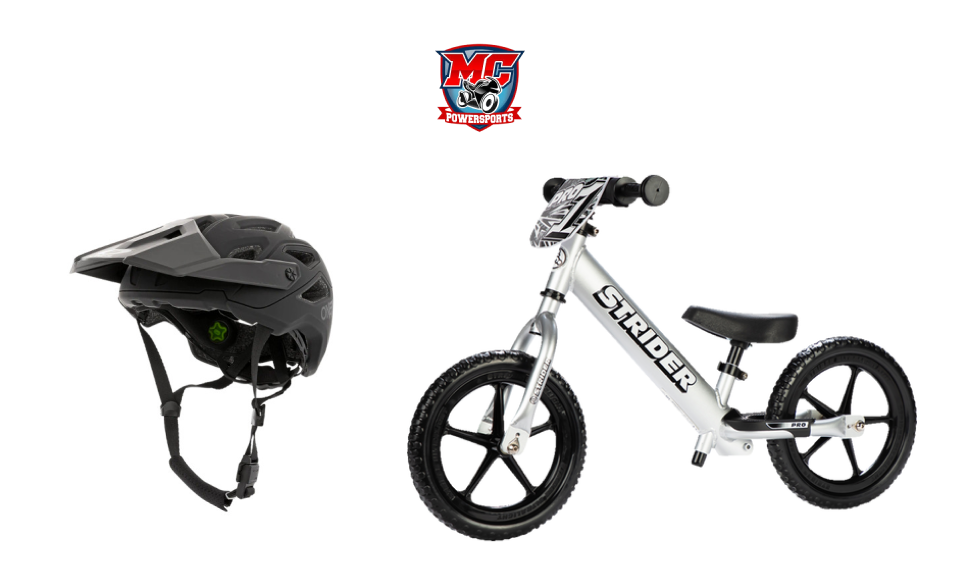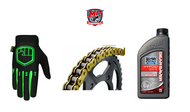Bicycle Gear Maintenance Tips to Extend Its Lifespan
Posted by undefined
Bicycles are awesome considering their ability to take you practically anywhere with nothing but determination and leg strength. The good thing about bicycles is that they're usually built to last, but they cannot do it all on their own.
Just like any good relationship, the one with your bike thrives on a little attention and care. Let's talk about the value of regular maintenance in extending the life of your bike and bicycle gear.
The Mighty Drivetrain: The Heart of the Ride
A bicycle's drivetrain includes the chain, the cassette (the cogs on the back wheel), and chainrings (the cog near the pedals). These are the workhorses of your bike, the parts that bear the brunt of every pedal stroke.
When they are dirty, they grind against each other, causing wear and tear at a massively fast pace, which is expensive to fix. So, the solution? Clean and care for it.
Regular cleaning and lubrication are the single most important things you can do. After a dusty or wet ride, your chain is essentially sandpaper wrapped around your cogs. Get rid of that gunk!
- Wipe Down the Grime: Use a rag to wipe down the chain and remove surface dirt.
- Degrease and Scrub: Apply a bike-specific degreaser to the chain and cassette. Use a dedicated chain cleaning tool or a stiff brush to scrub away the built-up sludge. An old toothbrush works well to get between the cassette cogs.
- Rinse and Dry: Rinse off all the cleaner with a gentle stream of water, being careful not to blast water directly into the bearing areas, which can wash out necessary grease. Thoroughly dry the entire drivetrain with a clean rag.
- Apply Lube: With the chain dry, apply a single drop of bike-specific chain lubricant to the top of each inner link as you slowly backpedal. Give it a moment to soak in, then wipe off any excess. Leaving too much lube on attracts more dirt.
Pro Tip: Check your chain for wear regularly using a simple chain checker tool. Replacing the chain when it is worn, but before it stretches too much, will save your much more expensive cassette and chainrings, potentially extending their life significantly.
Inspect the Body: Brakes and Tires
The best bicycles are just pieces of metal without proper brakes and tires. Before every ride, give your brake levers a squeeze. They should feel just right, not too firm nor spongy.
If you have disc brakes, listen for any grinding that would indicate worn pads. Safety first, always.
As for tires, many bicyclists are unaware that different terrains require different types of air pressure and tread. Riding on improperly inflated tires is a common mistake. Your bicycle's manual should have the pressure range, or it should be printed on the side of your tire. Also, keep an eye on your bicycle tire tread for excessive wear, cuts, or bulges.
The Most Important Piece of Bicycle Gear: Your Bicycle Helmet
In any list of bicycle gear for beginners or Pros, the bicycle helmet will always rank number 1. While it won't make your bike last longer, it will certainly allow you to ride for longer by protecting your head from injury.
However, helmets don't last forever. Replace a helmet immediately after a crash or if it has been in use for more than 3 to 5 years. Even without a crash, the materials in a helmet, like the foam and glue, naturally degrade over time from exposure to UV rays, sweat, and handling.
New helmets are also constantly being designed with better safety technology, making an upgrade worthwhile.

Storage Smarts: The Off-Season Strategy
Whether you are storing your bike for a week or the entire winter, where and how you store it matters. You don't want to leave it in the sun, outside, at the mercy of the elements. That's a surefire way to get rust everywhere.
Ideally, the bicycle should be placed in a dry, temperate location like a garage or basement. Before storing it long-term, give it a thorough clean, inflate the tires to prevent flat spots, and apply a light layer of lube to the chain. Covering it with a breathable cloth will keep dust off, ensuring it is ready for your next adventure.
Conclusion
A well-maintained bicycle is a joy to ride and a testament to the care of its owner. Simple, consistent habits like cleaning and lubing your drivetrain, checking your tires and brakes, and knowing when to replace key safety gear like your bicycle helmet are not just for performance, they extend the enjoyment and safety of every journey. Give your bike a little love, and it will repay you with thousands of miles of freedom.
Frequently Asked Questions
What should I do if my brakes squeak loudly?
Squeaking brakes often mean the brake pads or rotors are contaminated with dirt or oil, or the pads need better alignment. Clean the brake surface and pads with an approved cleaner. If the noise persists, your local bike shop can quickly adjust the alignment.
Is it okay to hang my bike by its wheels for storage?
Yes, it is perfectly fine to hang your bike by its wheels or frame. Hanging your bike saves space and does not damage the wheels or components. It is actually preferable for long-term storage as it keeps the tires off the ground, helping to prevent flat spots.
Should I use WD-40 on my bicycle gear?
No, you should not use WD-40 as a chain lubricant. While it is a great water dispersant and cleaning agent, it is not a lubricant and will quickly dry out the chain, leading to increased wear. Always use a lubricant made specifically for bicycle gear.

